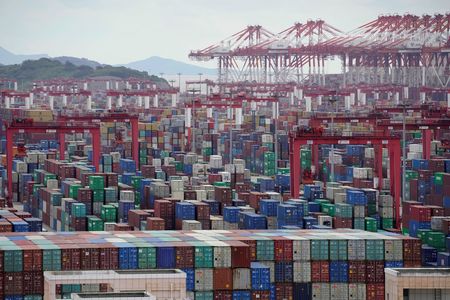By Ellen Zhang and Joe Cash
BEIJING (Reuters) – China’s exports shrank sharply in December as global demand cooled, highlighting risks to the country’s economic recovery this year, but a more modest decline in imports reinforced views that domestic demand will slowly recover in coming months.
While imports are expected to ride a wave of pent-up demand after China dropped its tough COVID-19 measures in December, its exports are seen weakening well into the new year as the global economy teeters on the brink of recession.
“The weak export growth highlights the importance of boosting domestic demand as the key driver for the economy in 2023,” said Zhiwei Zhang, chief economist at Pinpoint Asset Management, adding markets expect Beijing to announce more policies to support consumption.
Exports contracted 9.9% year-on-year in December, extending a 8.7% drop in November, though slightly beating expectations, customs data showed on Friday. The drop was the worst since February 2020.
Reflecting faltering world demand, outbound shipments to the United States shrank 19.5% in December, while those to the EU fell 17.5%, according to Reuters’ calculations based on the official data.
Despite the sharp falloff in shipments in the last few months, China’s total exports rose 7% in 2022 thanks to its strong trade with Southeast Asian nations as well as an export boom of new energy vehicles. Still, growth was a far cry from a 29.6% gain in 2021.
Imports fell 7.5% last month, moderating from a 10.6% decline in November and better than a forecast 9.8% decline.
China’s 2022 trade surplus hit an all-time peak of $877.6 billion, the highest since records started in 1950, compared with $670.4 billion in 2021.
DOMESTIC DEMAND KEY TO 2023 RECOVERY
Boosting domestic consumption will be vital to Beijing’s economic recovery plans, and there is lots of lost ground to recover — imports rose only 1.1% last year, down sharply from 30% growth in 2021.
China’s purchases of coal and copper shrank in December, as industrial activity slowed on a surge in COVID-19 infections.
Policymakers have pledged to increase support for the economy as they are eager to underpin growth and ease disruptions caused by the sudden end to COVID-19 curbs.
Measures to ease a crippling funding crunch in the property sector, in particular, could revive home sales and boost imports of industrial materials from iron ore to copper.
Lloyd Chan, senior economist at Oxford Economics, expects more support for property developers and households, but said net trade is still likely to be a drag on China’s growth this year.
“Any near-term lift is unlikely given weak domestic sentiment and the ongoing COVID surge.”
Graphic: China’s exports and imports contract in December https://www.reuters.com/graphics/CHINA-ECONOMY/TRADE/zdvxdrxogvx/chart.png
WEAK GLOBAL DEMAND COULD TEMPER ECONOMIC RECOVERY
China’s commerce ministry said on Thursday that slowing external demand and the rising risks of a global recession are posing the biggest pressures to the country’s trade stabilisation, leaving “arduous tasks.”
An official factory activity survey showed a sub-index of new export orders has remained in contraction territory for 20 consecutive months.
But the ministry said major exporting provinces have reported seeing some improvement in getting new orders. After three years, Chinese authorities have finally removed anti-virus curbs that disrupted port logistics and shut down factories in key manufacturing hubs.
REBOUND
Analysts polled by Reuters expect China’s economic growth to rebound to 4.9% in 2023, before steadying in 2024, a Reuters poll showed.
The economy likely grew just 2.8% in 2022 amid widespread lockdowns, well below the official target of around 5.5%. Fourth quarter and 2022 gross domestic product data (GDP) data will be released on Jan. 17.
IMF Managing Director Kristalina Georgieva said on Thursday she expected China to become a net contributor to the global economy by mid-2023, and urged Beijing to stay the course in reversing its earlier zero-COVID policy.
Analysts at the Bank of America expect China’s consumption to have a “faster and sharper” rebound than that seen in the rest of Asia.
But some manufacturers remain cautious about the outlook.
Jin Chaofeng, whose company in the east coast city of Hangzhou exports outdoor rattan furniture, said he has no market expansion or hiring plans for 2023.
“With the lifting of COVID curbs, domestic demand is expected to improve but not for exports…,” he said.
“With no signs of the ending of the Russia-Ukraine war or crucial improvement in China-U.S. relations, this year’s exports may be worse than 2022,” Jin said, adding his company has been reducing inventories over recent months.
(Reporting by Ellen Zhang and Joe Cash; Additional reporting by Shen Yan, Liangping Gao and Beijing newsroom; Editing by Bernard Orr and Kim Coghill)

